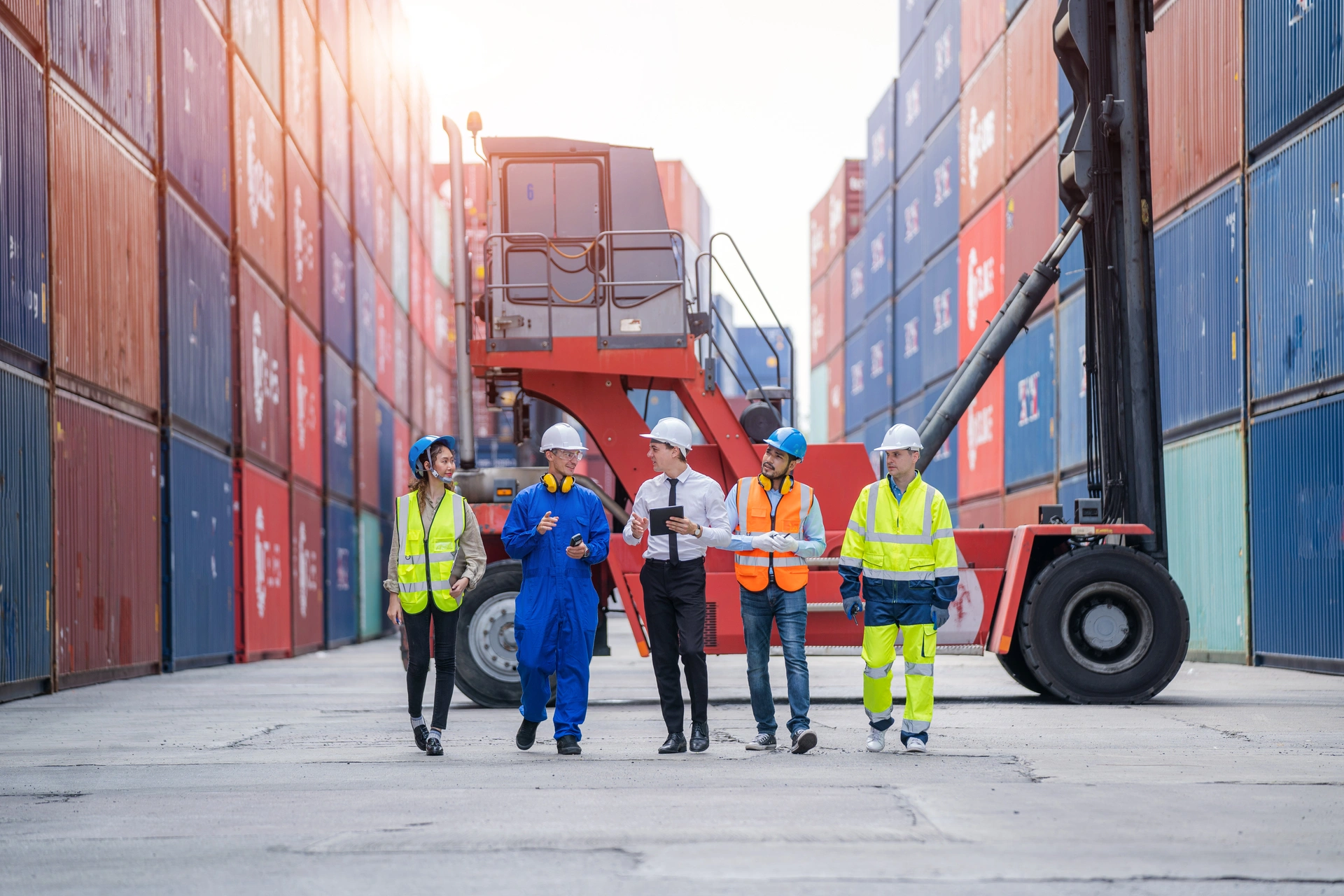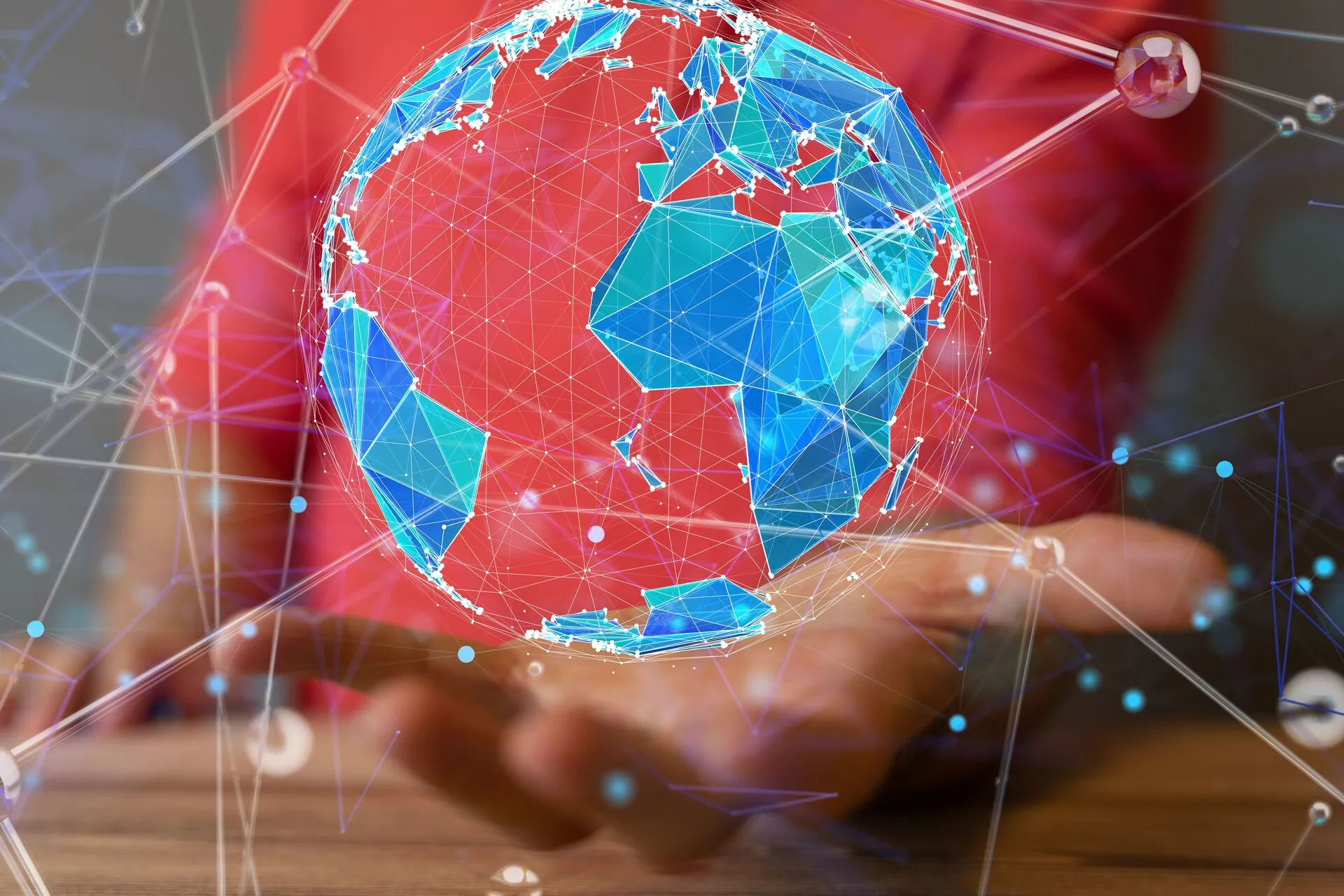Introduction
The world of logistics is undergoing a transformation unlike any other in history. Once dominated by manual processes, paperwork, and limited visibility, global supply chains are now powered by data, intelligence, and automation. The rise of Artificial Intelligence (AI), Automation, and the Internet of Things (IoT) is not just optimizing how goods move across borders, it’s redefining the very nature of global commerce. The global smart logistics market is projected to reach $48.4 billion by 2027, growing at a CAGR of 17.3%.
For businesses expanding internationally, logistics is no longer just about moving products from one point to another. It’s about ensuring reliability, reducing costs, enhancing customer experience, and building resilience in the face of disruptions. Smart logistics technologies provide the tools to achieve all of this at scale. According to McKinsey, companies that digitize supply chains can expect a 20–30% increase in efficiency and a 50% reduction in lost sales opportunities.
This article explores how automation, AI, and IoT are shaping global fulfillment, what it means for companies operating in multiple markets, and why these advancements matter for sustainable growth in the years ahead.
Automation – Building Efficiency at Scale
Logistics has always been about movement: moving goods, paperwork, and information. Traditionally, these movements depended on human labor at nearly every step, manual picking in warehouses, paperwork for customs, or drivers coordinating loads. But as global e-commerce volumes surge, manual systems cannot keep pace with the scale and speed required. By 2025, over 50,000 robotic warehouses are expected worldwide. This is where automation steps in as the backbone of modern logistics.
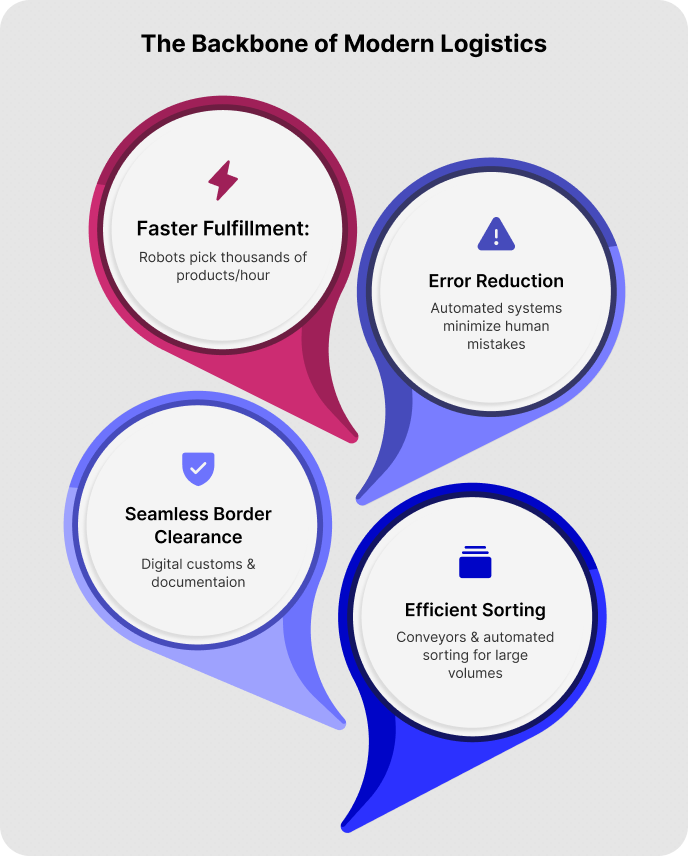
From robotic arms that can pick thousands of products per hour to self-navigating vehicles moving pallets across warehouses, automation eliminates bottlenecks and reduces errors that often frustrate customers. In a global market where speed is a competitive differentiator, automation allows businesses to scale without being limited by workforce size or physical processes.
Key Applications of Automation
- Warehouse Robotics: Automated picking and packing robots reduce errors and speed up order fulfillment.
- Automated Guided Vehicles (AGVs): Machines that move goods across warehouses without human operators.
- Automated Customs & Documentation: Systems that generate, check, and submit compliance documents to reduce delays at borders.
- Conveyor & Sorting Systems: Optimized handling of parcels and cargo in large fulfillment centers.
Why It Matters
Automation reduces dependency on manual labor, which is especially critical in regions with high labor costs or shortages. More importantly, it ensures consistency and scalability. McKinsey reports that warehouse automation can reduce operational costs by 20–40% while improving throughput by up to 25%. For global businesses, automation means faster order turnaround, lower operational costs, and fewer bottlenecks during peak demand seasons.
Artificial Intelligence – Smarter Decision-Making
Every global supply chain produces mountains of data: sales forecasts, inventory levels, customer behavior, weather conditions, and more. But data alone isn’t valuable, it’s the ability to process and act on that data in real time that creates business value. This is where Artificial Intelligence has revolutionized logistics.
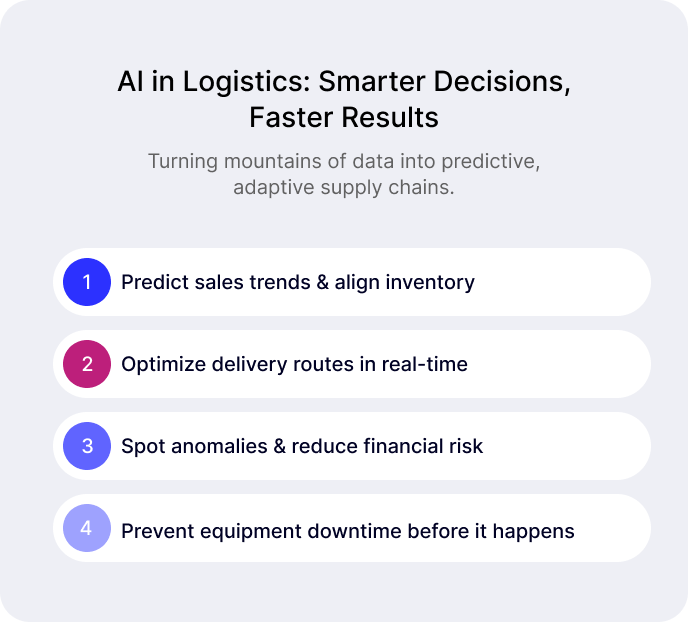
AI transforms reactive supply chains into predictive, adaptive systems. Instead of waiting for shortages, AI can anticipate spikes in demand. Instead of following fixed delivery routes, AI dynamically recalculates based on traffic or geopolitical disruptions. In other words, AI equips companies with the foresight to anticipate problems before they occur, minimizing risks in the highly complex world of cross-border fulfillment.
Key Applications of AI
- Demand Forecasting: Predicts sales trends across markets, helping businesses align inventory with customer needs.
- Dynamic Routing: AI systems continuously update delivery routes based on traffic, weather, and real-time constraints.
- Fraud Detection: Identifies unusual patterns in cross-border payments or transactions, reducing financial risks.
- Predictive Maintenance: Anticipates equipment failures before they occur, minimizing downtime in fulfillment centers.
Why It Matters
AI creates resilient and adaptive logistics systems. In global trade, conditions change daily, currency fluctuations, regulatory updates, or natural disruptions. According to PwC, AI in supply chain management could contribute up to $15.7 trillion in economic value by 2030. AI enables companies to stay ahead, ensuring customers receive reliable service regardless of external challenges.
Internet of Things (IoT) – Visibility Across Borders
One of the biggest frustrations in global commerce is the lack of transparency. When goods leave a factory or warehouse, companies often lose visibility until they arrive at the customer’s doorstep. This “blind spot” can last days or even weeks, creating uncertainty for businesses and customers alike. The Internet of Things solves this problem by creating continuous connectivity across the supply chain. DHL and Cisco estimate that IoT applications in logistics could create $1.9 trillion in value for the industry.
%20%E2%80%93%20Visibility%20Across%20Borders.png)
Through smart sensors, trackers, and real-time monitoring, IoT provides businesses with full visibility, whether it’s ensuring a shipment of medicine remains within a safe temperature range, or tracking a delivery truck across borders. In a world where customer trust depends on reliability, IoT transforms global fulfillment into a transparent and accountable process.
Key Applications of IoT
- Smart Sensors in Containers: Monitor temperature, humidity, and shock levels for sensitive goods like pharmaceuticals or electronics.
- GPS Tracking: Ensures real-time visibility of shipments across geographies.
- Connected Warehousing: Sensors track inventory levels automatically, preventing stockouts or overstocking.
- Condition Monitoring: Alerts when goods are mishandled, enabling accountability and corrective action.
Why It Matters
Global trade often spans multiple vendors, borders, and transportation modes. Without IoT, businesses face blind spots in their supply chain. IoT provides the transparency and trust needed to reassure customers, reduce risks, and comply with international regulations.
Integration of Automation, AI, and IoT
Although automation, AI, and IoT are powerful on their own, they unlock the greatest value when they operate together. Many businesses make the mistake of adopting them in silos, investing in robotics for efficiency, or AI for forecasting, or IoT for tracking—without considering how these systems connect. True smart logistics emerges when these technologies work as a unified ecosystem.
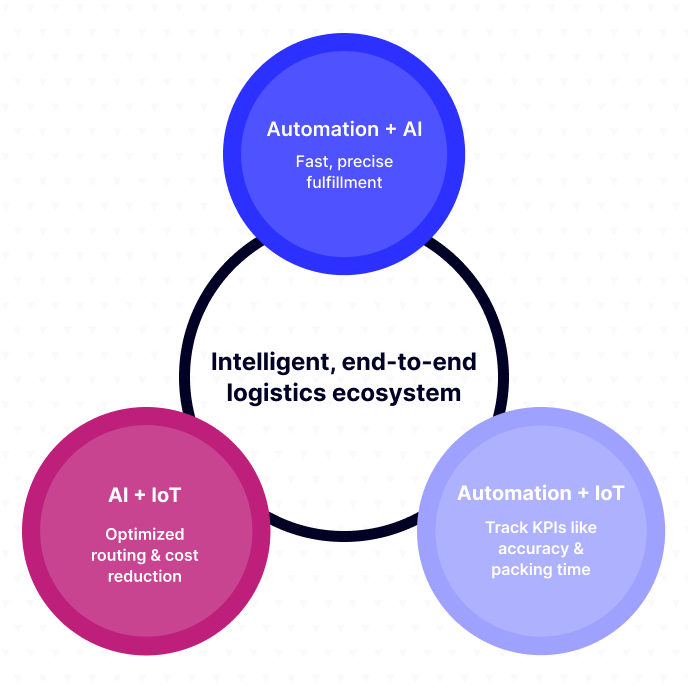
For example, AI can analyze IoT data from a shipment, predict a delay, and immediately trigger automated systems to reroute or reallocate inventory. Integration ensures that logistics is not a patchwork of tools, but a cohesive, intelligent network capable of adapting to the complexities of global commerce.
- Automation + AI: AI forecasts demand, while automation executes fulfillment with speed and precision.
- AI + IoT: AI analyzes real-time IoT data to optimize routes and reduce costs.
- Automation + IoT: Automated systems respond instantly to IoT alerts, such as rerouting temperature-sensitive goods.
Why It Matters
Integration eliminates silos in logistics. Instead of fragmented solutions, businesses benefit from an end-to-end, intelligent fulfillment ecosystem that reduces errors, increases visibility, and delivers consistent customer experiences worldwide. According to Deloitte, companies that integrate automation, AI, and IoT report 30% higher supply chain visibility and 25% faster decision-making.
Challenges in Smart Logistics Adoption
The promise of smart logistics is compelling, but adopting these technologies isn’t without obstacles. Many companies, especially those expanding into global markets for the first time, struggle with the costs and complexities of implementing new systems. Beyond finances, integration across borders often means dealing with fragmented infrastructure, regulations, and technology standards. Security concerns also emerge, as connected systems can expose businesses to cyberattacks.
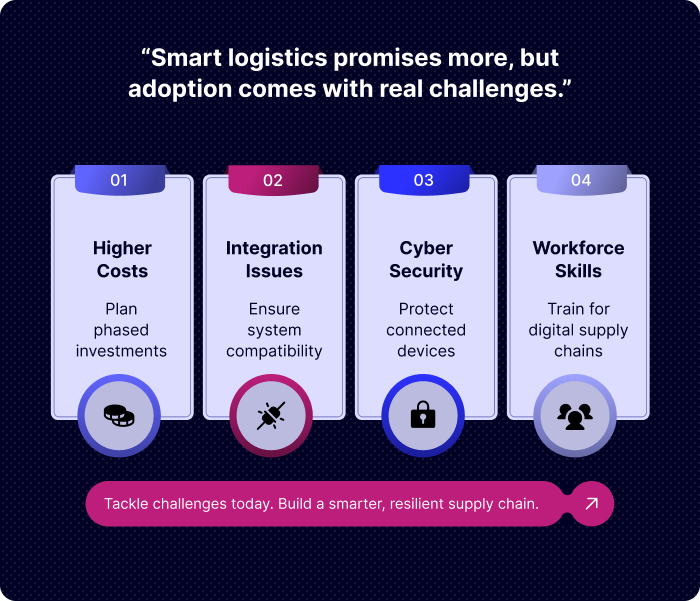
Finally, technology is only as good as the people who manage it, and there is a growing need for a workforce skilled in digital supply chains. Recognizing these challenges is not about discouragement—it’s about ensuring companies make realistic, phased decisions that lead to successful long-term adoption. Cybersecurity remains a concern: 54% of logistics firms faced at least one cyberattack on IoT-enabled systems in 2023 (World Economic Forum).
While the potential is huge, companies face barriers in adopting these technologies.
- High Initial Investment: Robotics, AI platforms, and IoT sensors require significant upfront capital.
- Interoperability Issues: Systems from different vendors may not integrate seamlessly.
- Cybersecurity Risks: Connected devices introduce vulnerabilities to cyberattacks.
- Skilled Workforce Gaps: Employees need training to work with advanced technologies.
Why It Matters
Understanding these challenges ensures companies adopt realistic, phased strategies instead of over-investing too quickly. Successful adoption requires balancing innovation with practicality.
The Global Perspective
While logistics technology is advancing globally, its adoption looks very different depending on the region. Developed markets often have the infrastructure and resources to embrace robotics and AI, while emerging markets may lean more heavily on IoT solutions to bridge infrastructure gaps. Regulatory requirements, consumer expectations, and cost structures also vary widely. In Europe, € 7.0 billion of logistics investments in 2023 were directed toward sustainability-driven automation (European Logistics Association).
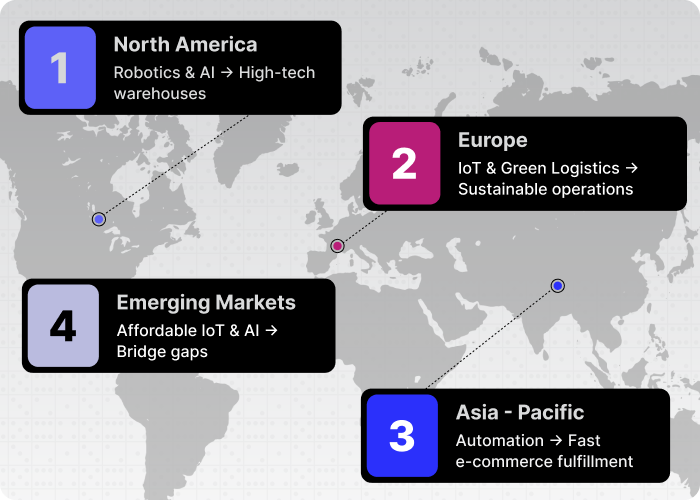
Understanding these differences is critical for any company looking to expand internationally. Smart logistics, therefore, cannot be approached as a “one-size-fits-all” model—it must adapt to local realities while staying connected to a broader global strategy.
Smart logistics doesn’t look the same everywhere. Adoption varies by region:
- North America: High investment in robotics and AI-driven warehousing.
- Europe: Strong emphasis on sustainability and green logistics, powered by IoT.
- Asia-Pacific: Rapid adoption of automation due to booming e-commerce and mega-warehouses.
- Emerging Markets: Focus on affordable IoT tracking and AI solutions to overcome infrastructure gaps.
Why It Matters
For companies expanding globally, understanding regional logistics trends is essential. Tailoring logistics strategies to local realities increases efficiency and reduces wasted investment.
The Future of Global Fulfillment
The pace of innovation in logistics shows no signs of slowing down. The technologies available today, automation, AI, and IoT are only the beginning of what’s possible. Tomorrow’s fulfillment networks will include autonomous vehicles delivering goods, drones managing last-mile logistics, blockchain securing supply chain transparency, and AI optimizing sustainability efforts.
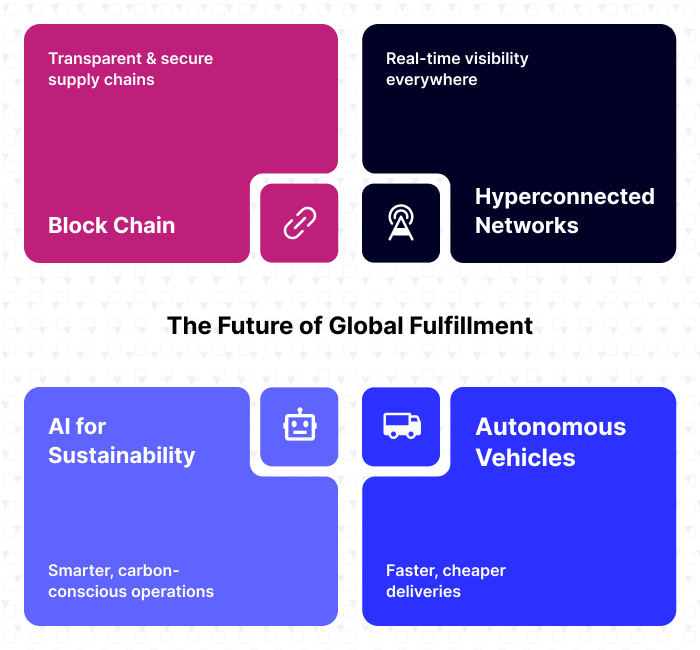
Companies that prepare for these shifts now will position themselves as leaders in global commerce. The future of logistics isn’t just about faster delivery; it’s about building supply chains that are smarter, more resilient, and customer-focused.
Looking ahead, smart logistics will continue to evolve:
- Autonomous Vehicles & Drones: Reducing delivery times and costs.
- Blockchain in Logistics: Enhancing transparency and reducing fraud.
- AI-Driven Sustainability: Optimizing carbon-neutral supply chains.
- Hyperconnected Networks: End-to-end real-time visibility across suppliers, distributors, and customers.
Why It Matters
Businesses that adopt these innovations early will gain a competitive advantage. Logistics will no longer just be a cost center—it will become a driver of customer loyalty and brand differentiation. By 2030, 30% of last-mile deliveries in urban areas are expected to be carried out by autonomous vehicles or drones.
Conclusion – Building Smarter Supply Chains
Automation, AI, and IoT are not just buzzwords—they are the building blocks of the future of logistics. Together, they transform fulfillment from a behind-the-scenes function into a competitive advantage that drives growth in international markets.
Companies that embrace these tools will not only meet customer expectations but also gain resilience against global disruptions. The real challenge lies not in whether to adopt these technologies, but in how quickly and strategically businesses can integrate them into their global operations.
At Filuet, we’ve seen how combining automation, AI, and IoT enables businesses to expand globally with confidence, speed, and reliability.
.webp)


